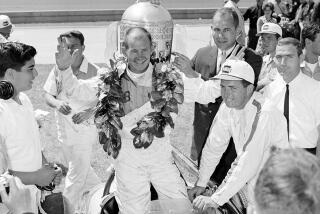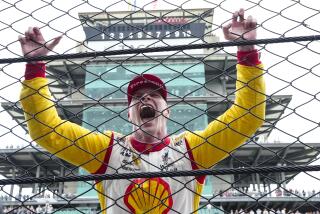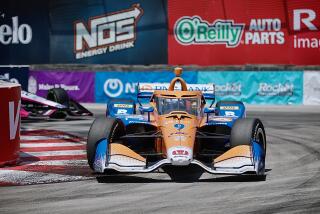Pit Crew Fills Need for Speed : 25-Member Kraco Team Makes Valiant Effort in 4th-Place Run
Inside a tent, men with serious expressions bent over a high-powered race car and its snarling engine. Drawn by the noise and a behind-the-scenes drama, camera-armed fans crowded the tentâs entrance and stared intently.
It was 8:30 Sunday morning, 3 1/2 hours before the Long Beach Grand Prix, and the Kraco race team was concerned. The engine was not the one it had intended to use.
The one that had been built the week before at the company plant in Compton specifically for the Grand Prix had misfired during qualifying laps Saturday. The crew had been in this Indy car garage area until 11 Saturday night, installing the back-up Cosworth engine, and also rebuilding the gear box.
âWith a new motor, you always feel a little uneasy,â said Barry Green, chief mechanic and manager of the 25-member team.
In pre-race forecasts, the Kraco car driven by Bobby Rahal was not mentioned as a possible winner. Even with its No. 1 engine its average speed Saturday had been 88.4 m.p.h., more than 2 seconds slower than the top qualifier, Al Unser Jr.
But Green, a well-tanned man who spoke with an Australian accent, looked calm. He has been in the racing business long enough to know that setbacks--despite the state-of-the-art equipment and the continual tinkering and fine tuning--can be expected.
Easier to Change Than Fix
As to what exactly had gone wrong, there was no immediate answer. âThere are so many electronic devices on these damn things,â Green said.
Looking up from his tinkering, Wayne Eaton, a stocky, curly-haired mechanic, said: âItâs easier to change the engine than fix the problem.â
Steve Newey, head engineer, observed the mechanics as they meticulously probed the motor with their tools. The situation, he allowed, was a little nerve-racking.
âAnytime you go into a race with an engine without testing it on the track, itâs a bit of a gamble,â Newey said. âThe other engine had been built with brand new components and there were no track miles on it.â (The replacement had been used the week before in a race at Phoenix.)
There had been another headache--Rahal could not turn properly in the corners of the 1.67-mile road course during qualifying. Adjustments to the Lola chassis also had been made Saturday night.
âWeâre certainly due for a good day,â Green said.
With grease under their fingernails and hope in their hearts, the team members went about their tasks as eagerly as a youngster working on his first car.
Frustrated Drivers
They labored anonymously. The people outside took their pictures, but did not know their names. They probably were unaware that these men, according to Green, were frustrated race drivers who have found that working on the cars is the next best thing.
âBobby does the job for us, but we all have the same desire to win, the same killer instinct,â said Green, a former driver himself.
The revving finally stopped. The $335,000 car, its blue and yellow skin emblazoned with advertising, was towed out to pit row.
At 10:45, the mechanics, who had changed into yellow fire-retardant suits, had their âpregameâ meal--a box lunch.
At 11 the car, ringed by fans, was wiped and rubbed until it glistened.
Seven minutes later, Rahal appeared, also in a yellow suit. An affable man (âHe takes us to dinner,â one of the mechanics said) wearing a mustache and glasses, Rahal accepted handshakes from well-wishers. A former Indy 500 winner, he is in his first season with Kraco and has a salary of more than $1 million this year.
He posed with Maurice Kraines, chairman of the board of Kraco, and a guest of Kraines.
âWe Think Weâre Going to Winâ
âThe car is great, we have a great driver,â Kraines said. âWhen we go into a race, we think weâre going to win.â
Kraco, which became involved in Indy car racing in 1981, has seven victories in the last three years. It won at Long Beach in 1986 with Michael Andretti driving.
Anticipation, not nervousness, was what Rahal said he felt as he sat on the pitâs low concrete wall and waited. Soon he would descend into the tight black hole that is the cockpit and drive at prodigious speeds.
âPeace,â he said, describing the feeling he gets when he climbs into the car.
The 725-horsepower engine was started, spitting an ear-splitting tune. âSounds good now,â Green said.
âYou got a small crescent wrench, Phil?â one crewman asked another.
The car was towed out to the track, laid out on Shoreline Drive, in front of full grandstands and beneath a hazy sky that held a blimp and a reluctant sun. During the national anthem, Rahal looked down at the car and then up at a buzzing plane that pulled a sign.
At 11:50 he kissed his wife Debi, gave her his watch and got in the car.
Streaks of Color
With the roar of 28 engines in his ears, a crew member smoothed one of Rahalâs thick tires with his hand and left the track.
The race started, the cars screaming, 190 m.p.h. streaks of color.
âGo, Bobby,â a fan near the pit yelled.
The crew members watched, each with a foot up on the low wall, but their view was not good. They could see only the tops of the cars as they went by every minute and 20 seconds. Graham Western, the engine engineer, held a clipboard and jotted figures on fuel consumption. On the timing stand, a computer revealed the race standings. Kraines and Green held walkie-talkies, over which they could hear Rahal.
The pit was furnished with a fuel tank, a maze of hoses, several tool chests and tires--âR, Set 7, 1st Stopâ was scrawled on one.
At 12:18 the public address announcer said that Rahal was in fifth place.
The first pit stop was a blur of activity. Eaton, wearing a hood and helmet, pumped in fuel. Other mechanics ripped off tires and put on new ones, tightening the lugs with a loud air wrench. After only 18 seconds, Rahal was back on the track.
Engine Dies in Spin-Out
At the race midpoint, Rahalâs brakes failed as he went into the first turn. He spun out. The engine died. But race workers push-started the car and Rahal, now down a lap, continued. He had dropped to seventh.
Rahalâs second pit stop took only 9 seconds. While the driver grabbed a water bottle, drank from it and tossed it away, 16 gallons of fuel were put in.
Rahal was moving up, but his exact progress, as reported by the track announcer, was drowned out by the incessant roar of engines.
Late in the race there was wild cheering in the adjoining pit occupied by the Al Unser Jr. team. A large crowd of fans had gathered behind that pit. Unser had just taken the lead after ramming Mario Andrettiâs car.
No crowd was behind the Kraco pit. The mechanics looked to their left and saw Unser Jr. crew members hugging one another.
Fourth-Place Finish
Close to 2 p.m. the race ended. Rahal, who had finished 94 of 95 laps and a strong fourth, arrived back at the pit and took off his gloves. Kraines and Green bent close to him to say a few words.
Rahal, his hair wet and matted, got out and said: âI ache, just from being shook. Iâm whipped.â
âHe did a beautiful job,â Kraines said. âIâm happy with the car, happy with Bobby . . . weâre gaining.â
After discussing technical matters, Green grabbed Rahalâs knee as they sat on the pit wall and said, âGood run, mate.â
Eaton was loading tires for the trip back to the garage area when Rahal said to him: âYouâre in a little bit of the money today.â
The purse for fourth place was $54,460.
âI can buy a beer,â Eaton said. After a weekend of hard work, there would be no crying in it.
âItâs the beginning of the season,â the mechanic shrugged. âWe stuck together and nothing fell off.â
More to Read
Go beyond the scoreboard
Get the latest on L.A.'s teams in the daily Sports Report newsletter.
You may occasionally receive promotional content from the Los Angeles Times.










